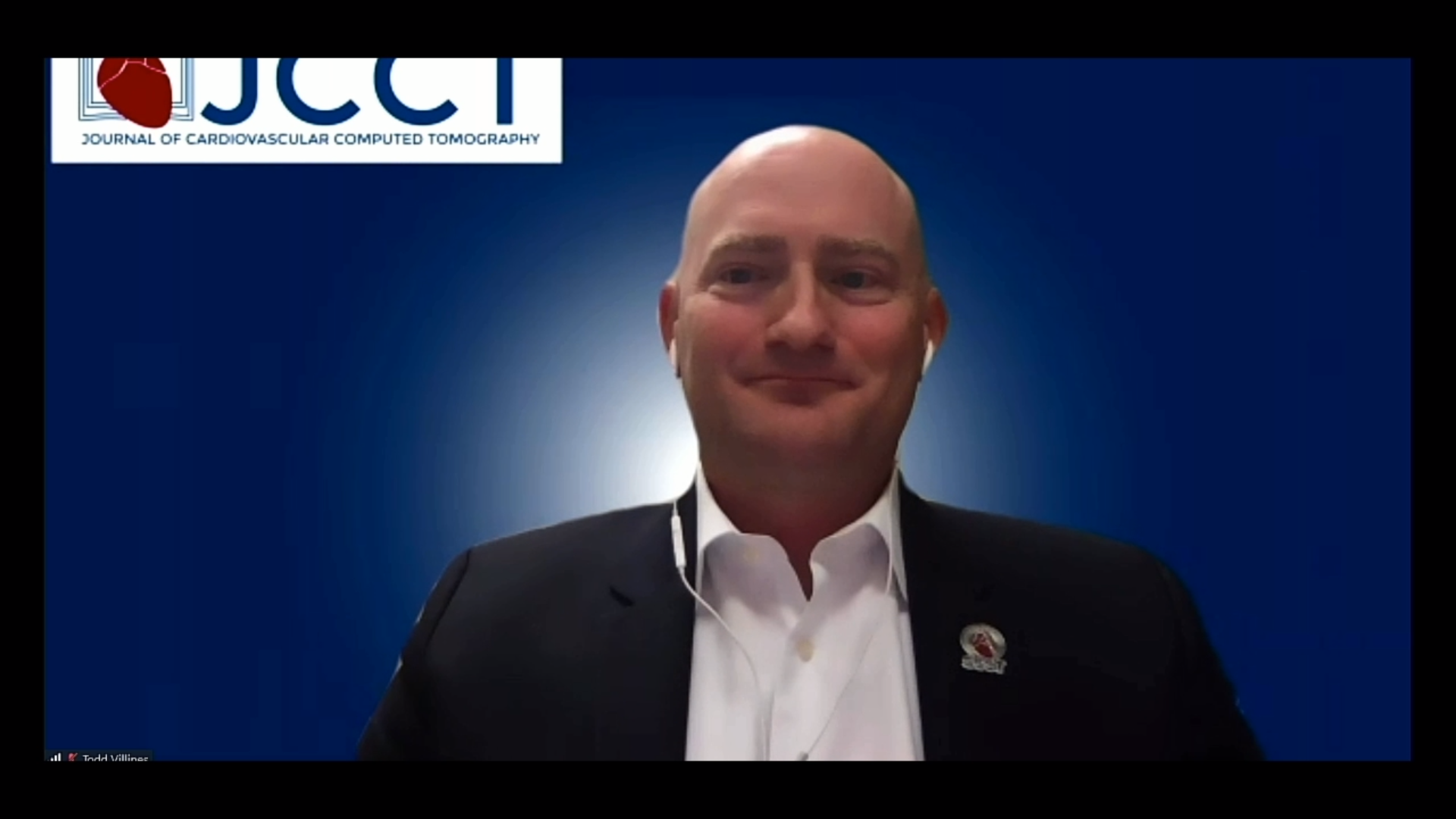ISCHEMIA, Patient Age in PROMISE Among Top CT Papers of the Year at SCCT
While research has shifted to COVID-19 in recent months, there are plenty of ongoing CT studies, experts say.

The biggest research news in the field of cardiac CT over the past year spans from the blockbuster ISCHEMIA trial to a deep dive into automated plaque imaging and studies with a strong focus on high-risk populations, among other topics, according to a talk kicking off the Society of Cardiovascular Computed Tomography (SCCT) virtual meeting Friday morning.
For his “top eight” list, Todd Villines, MD (University of Virginia, Charlottesville), said that he excluded guideline publications and societal statements from his presentation. Instead, Villines “tried to prioritize research that would impact clinical practice in an immediate or near-immediate term.”
Notably, while papers in cardiac CT have been steadily increasing over the past two decades, there was a drop earlier this year when the COVID-19 pandemic set in, he said. “What happened in March is that obviously the world became very focused on COVID, but I think as a result of that you will see that this trend and the clinical utilization of CT progresses.”
Commenting on the temporal decline in cardiac CT research for TCTMD, SCCT President Ron Blankstein, MD (Brigham and Women's Hospital, Boston, MA), said while there might have been a recent dip in research reports unrelated to COVID-19, he has seen a surge in studies related to the pandemic. “I'm not concerned,” he said. “I think, if anything, there are people who have actually been doing more research during this time because clinical work at least for a little bit went down. . . . The only concern long-term is really funding, because if our government devotes so many resources to COVID, it's still unclear to me—and I'm saying this also wearing my researcher hat—if [the National Institutes of Health will] continue to fund research in other areas to the same level as before.”
Stable Ischemic Heart Disease, Plaque Imaging
In no specific rank order, Villines outlined his picks for the most newsworthy papers in cardiac CT, beginning with ISCHEMIA. Presented at the 2019 American Heart Association Scientific Sessions, the NIH-funded trial showed that an invasive strategy on top of optimal medical therapy (OMT) offers no benefit beyond OMT alone in preventing a range of major cardiovascular events in patients with stable, moderate-to-severe coronary artery disease. There also were implications for coronary CT angiography (CTA).
“if you look at the results of ISCHEMIA, it was anatomy that predicted outcomes and ischemia did not, which lends indirect support to coronary CTA as a first-line test,” Villines said. “It also teaches us that if we have patients who have moderate-to-severe ischemia on stress testing, perhaps reflexively sending them to the cath lab is not the best answer and in fact they might be best assessed with coronary CTA. I think more importantly, if we see stenosis on CTA that medical therapy is probably best for most of our patients, and this may lead to less downstream testing following CTA.”
In the same theme of stable ischemic heart disease, his second pick was the PROMISE trial’s age substudy, which looked at the relative predictive accuracy of cardiac CT for events compared with functional tests in patients younger than 65 years old compared with older cohorts. In the analysis, both coronary CTA and coronary artery calcium (CAC) score appeared to be better at risk prediction in patients younger than 65 years, while functional tests were better at predicting future risk for older adults.
 “In fact, if you recall from the PROMISE study, the majority of events occurred in those with normal functional tests,” Villines said. “Whereas over 65, we saw that that was really where the value of functional testing was, particularly if you had significant calcium. I think that this highlights that in our younger population, especially those, CTA really should be our first-line test.”
“In fact, if you recall from the PROMISE study, the majority of events occurred in those with normal functional tests,” Villines said. “Whereas over 65, we saw that that was really where the value of functional testing was, particularly if you had significant calcium. I think that this highlights that in our younger population, especially those, CTA really should be our first-line test.”
He also chose to highlight a machine-learning subanalysis of the SCOT-HEART trial that looked at assessing low-attenuation plaque to predict MI. The study showed that the semi-automated detection of low-attenuation plaque burden was superior to a CV risk score, coronary artery calcium (CAC), Agatston units, and presence of obstructive coronary artery disease.
The study showed “the potential for incorporating plaque quantification into our evaluation,” Villines said.
Prevention, High-risk Populations
Next, he pointed to a paper from the Western Denmark Heart Registry last month looking at calculating the number needed to treat to prevent an atherosclerotic cardiovascular disease event following coronary CTA. “Prevention guidelines do not take into account the findings of coronary CTA,” he said, pointing to the study finding that shows a number needed to treat of 233 in patients with no plaque compared with 96 in patients with nonobstructive CAD with CAC under 400 over 6 years.
“Nonobstructive disease changes [that number] drastically and highlights the importance of CTA findings in dictating aggressiveness of medical therapy with regards to both statins and potentially even non-statin therapies,” Villines observed.
The “new era” of coronary CTA will be its use within high-risk populations, he said, including two similar studies of patients with NSTE ACS to highlight this concept. First, the VERDICT trial, presented at the 2018 European Society of Cardiology Congress but published this February in the Journal of the American College of Cardiology, included about 80% of patients with elevated troponins and showed a negative predictive value of over 90% and a sensitivity of almost 97% with CTA prior to catheterization. “This is a population that we traditionally have not scanned, but I think it highlights that in fact many patients in whom a conservative management strategy is preferred, perhaps doing a CTA is ideal,” Villines said.
The CARMENTA trial, published in 2019, randomized patients with definite NSTEMI without an alternative etiology to a comprehensive stress cardiac magnetic resonance protocol, coronary CTA, or catheterization. “What we saw was coronary CTA was able to safely defer referral in about a third of patients, very similar to VERDICT,” Villines summarized. “In fact, this was actually the safest strategy—doing imaging before going to the cath lab actually had the lowest event rates. And so [this highlights] the potential role in this population.”
MAC and CAC
Also making Villines’ list was a study published in May looking at a CT-based mitral annular calcification (MAC) score. While it was small and registry-based, the paper is important because “in the past we've not had a way of quantifying MAC,” Villines said. “We look at it and say, ‘This is a little bit. This is a lot.’”
However, the researchers found that the score they developed was able to predict whether there is enough calcium to anchor a valve or if there is perhaps an increased risk of embolization and migration. “Despite it requiring further validation and being a small study, this is likely a score you will see used to select patients for both procedures and valve type,” he predicted.
Finally, research on CAC scoring broke new ground in the last year. In the first of two papers included by Villines, more than 7,000 patients underwent nongated CT scans or dedicated calcium scoring and a machine learning algorithm was used to not only detect calcium but also quantify it compared with Agatston scoring. “What they showed is regardless of the technique, this algorithm had a very high sensitivity and overall high accuracy, and it can be run automatically regardless of the type of scan acquisition,” he said. “This really has some important clinical implications regarding the use of automated calcium scoring across a variety of noncontrast chest CT scans to improve our ability to apply prevention in a patient which is often overlooked.”
Secondly, a subanalysis of the MESA study looked at both the impact of aspirin and the role of CAC scoring in primary prevention among patients under 70 years old not deemed to be at high bleeding risk. “Several recent clinical trials have questioned the benefit of aspirin, in fact guidelines now state to not use aspirin if you are under 70,” Villines said. “What was shown is that overall in MESA there was no benefit to aspirin unless your calcium score was over 100. In fact, the number needed to harm outweighed the number needed to treat unless your calcium score was elevated. So I think this is very informative.”
Commenting on the session as a whole, Blankstein said, “it's really an impossible task to pick only eight [papers], and there's been so much research and so many great papers in the last year really reflecting how active and how dynamic the field is right now. I think [Villines] really nailed down some of the key ones.”
Yael L. Maxwell is Senior Medical Journalist for TCTMD and Section Editor of TCTMD's Fellows Forum. She served as the inaugural…
Read Full BioSources
Villines TC. Top 8 papers in cardiovascular CT over the past year. Presented on: July 17, 2020. SCCT 2020.
Disclosures
- Villines reports no relevant conflicts of interest.
- Blankstein reports receiving grants and research from Amgen and Astellas.


Comments